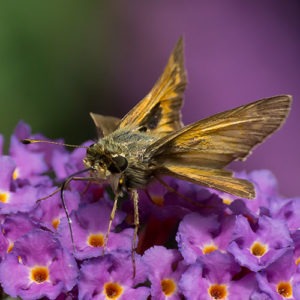Over the last week, I’ve noticed an increase in the number of brightly yellow tiger-swallowtail butterflies. Tiger-swallowtails are one of my favorite Kentucky butterflies and I love taking pictures of them on the milkweed and other wildflowers on our farm. However, there is another group of butterflies that I have also grown to appreciate over the last couple of years.

Skippers are a family of small to medium sized butterflies that are usually brown or dull orange. It is relatively easy to identify a butterfly as a skipper. The most obvious characteristic is how they hold their wings. When a skipper has landed, it tends to hold its back wings flat like a table top and its front wings up at an angle. I think it makes their wings look like the sails on a ship. Another characteristic that can be used to identify a butterfly as a skipper are the bulbs at the end of its antennae. The bulbs at the end of a skipper’s antennae are curved, instead of straight like most butterflies.
Identifying a skipper to species can be much harder than identifying it just to the skipper family because many species of skippers look very similar. In fact, there are a few species which even experts can’t distinguish between in the field. However, other species, like the sachem skipper (Atalopedes campestris) and the silver-spotted skipper (Epargyreus clarus), aren’t too hard to identify.
In general skippers are fairly common, but are often over-looked because they are small and drab compared to their flashier cousins like the tiger-swallowtails, monarchs, and other large, colorful butterflies. The Society of Kentucky Lepidopterists’ website lists over 50 species of skippers that have been recorded in Kentucky.
Supposedly skippers got their name because of the way they fly. Skippers fly in a jerky fashion, especially when flying from one flower to the next. Apparently, someone thought it looked like they were skipping through the air from one flower to the next.
Like many other butterflies, the adults will feed on a variety of flowers. Depending on the species, skippers can go through 2-4 generations in a single year in Kentucky. The last generation of the year will overwinter as a chrysalis.
The caterpillars for most skipper species eat grasses. The female will lay a single egg on a blade of grass, then move to another blade of grass and deposit another egg. Before I learned that grasses are the host plants for skipper caterpillars, I couldn’t figure out why skippers seemed to land on grass so often instead of flowers. Now it makes much more sense.

Different species of skipper caterpillars eat different species of grass. The sachem skipper caterpillar eats a lot of Bermuda grass and crabgrass which is always a good thing in my book. One exception to the “skipper caterpillars eat grass” rule is the silver-spotted skipper. Silver-spotted skipper caterpillars eat legumes, especially the leaves of black locust, honey locust, and false indigo bush.
A skipper caterpillar will roll a grass blade (or leaf in the case of the silver-spotted skipper) up to hide in when it isn’t feeding. As the caterpillar grows, it may become too big to hide in a single blade of grass or leaf so it may stitch a couple of leaves or blades of grass together with silk to make a larger hiding place. By hiding in the rolled up grass, it is able to avoid many of its predators.
However, some of the skipper’s predators, especially certain types of wasps, have learned to recognize the rolled up leaves as containing tasty prey. These wasps sting the caterpillar to paralyze it, then hauls the caterpillar back to their nests where they seal it up with their eggs. When the wasp’s eggs hatch, the larvae have fresh meat in the form of the caterpillar waiting for them.
Skippers may not be the largest or flashiest of Kentucky’s butterflies, but they have a very interesting life history. They are also relatively common and easy to identify, at least to family, once you start looking for them. So this summer I encourage you not to overlook the smaller butterflies as you admire their larger cousins too.

This article was part of Shannon’s original Kentucky Pollinators and Backyard Wildlife blog which evolved into the blog for Backyard Ecology.

Backyard Ecology: Exploring Nature in Your Backyard
Nature isn’t just “out there.” It’s all around us, including right outside our doors. Hi, my name is Shannon Trimboli, and I am the host of Backyard Ecology. I live in southcentral Kentucky and am a wildlife biologist, educator, author, beekeeper, and owner of a nursery specializing in plants for pollinators and wildlife conservation. I invite you to join me as we ignite our curiosity and natural wonder, explore our yards and communities, and improve our local pollinator and wildlife habitat. Learn more or subscribe to my email list at www.backyardecology.net.

Leave a Reply